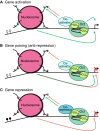Oct transcription factors in development and stem cells: insights and mechanisms
- PMID: 23821033
- PMCID: PMC3699277
- DOI: 10.1242/dev.095927
Oct transcription factors in development and stem cells: insights and mechanisms
Abstract
The POU domain family of transcription factors regulates developmental processes ranging from specification of the early embryo to terminal differentiation. About half of these factors display substantial affinity for an 8 bp DNA site termed the octamer motif, and are hence known as Oct proteins. Oct4 (Pou5f1) is a well-known Oct factor, but there are other Oct proteins with varied and essential roles in development. This Primer outlines our current understanding of Oct proteins and the regulatory mechanisms that govern their role in developmental processes and concludes with the assertion that more investigation into their developmental functions is needed.
Keywords: Oct proteins; POU domain; Stem cells.
Figures


Similar articles
-
POU domain factors in neural development.Adv Exp Med Biol. 1998;449:39-53. doi: 10.1007/978-1-4615-4871-3_4. Adv Exp Med Biol. 1998. PMID: 10026784 Review.
-
The POU domain transcription factors Oct-6 and Oct-11 negatively regulate loricrin gene expression in keratinocytes: association with AP-1 and Sp1/Sp3.Arch Dermatol Res. 2013 Jul;305(5):371-8. doi: 10.1007/s00403-013-1317-x. Epub 2013 Jan 23. Arch Dermatol Res. 2013. PMID: 23341029
-
Sequential expression of multiple POU proteins during amphibian early development.Mol Cell Biol. 1992 Feb;12(2):638-49. doi: 10.1128/mcb.12.2.638-649.1992. Mol Cell Biol. 1992. PMID: 1732736 Free PMC article.
-
Oct-3/4 dose dependently regulates specification of embryonic stem cells toward a cardiac lineage and early heart development.Dev Cell. 2006 Oct;11(4):535-46. doi: 10.1016/j.devcel.2006.07.013. Dev Cell. 2006. PMID: 17011492
-
Oct-4: gatekeeper in the beginnings of mammalian development.Stem Cells. 2001;19(4):271-8. doi: 10.1634/stemcells.19-4-271. Stem Cells. 2001. PMID: 11463946 Review.
Cited by
-
pouC Regulates Expression of bmp4 During Atrioventricular Canal Formation in Zebrafish.Dev Dyn. 2019 Feb;248(2):173-188. doi: 10.1002/dvdy.2. Epub 2018 Dec 10. Dev Dyn. 2019. PMID: 30444277 Free PMC article.
-
Tracing the origins of glioblastoma by investigating the role of gliogenic and related neurogenic genes/signaling pathways in GBM development: a systematic review.World J Surg Oncol. 2022 May 10;20(1):146. doi: 10.1186/s12957-022-02602-5. World J Surg Oncol. 2022. PMID: 35538578 Free PMC article.
-
The POU/Oct Transcription Factor Nubbin Controls the Balance of Intestinal Stem Cell Maintenance and Differentiation by Isoform-Specific Regulation.Stem Cell Reports. 2018 May 8;10(5):1565-1578. doi: 10.1016/j.stemcr.2018.03.014. Epub 2018 Apr 19. Stem Cell Reports. 2018. PMID: 29681543 Free PMC article.
-
VL30 retrotransposition is associated with induced EMT, CSC generation and tumorigenesis in HC11 mouse mammary stem‑like epithelial cells.Oncol Rep. 2020 Jul;44(1):126-138. doi: 10.3892/or.2020.7596. Epub 2020 Apr 28. Oncol Rep. 2020. PMID: 32377731 Free PMC article.
-
Human photoreceptor cells from different macular subregions have distinct transcriptional profiles.Hum Mol Genet. 2021 Jul 28;30(16):1543-1558. doi: 10.1093/hmg/ddab140. Hum Mol Genet. 2021. PMID: 34014299 Free PMC article.
References
-
- Andersen B., Weinberg W. C., Rennekampff O., McEvilly R. J., Bermingham J. R., Jr, Hooshmand F., Vasilyev V., Hansbrough J. F., Pittelkow M. R., Yuspa S. H., et al. (1997). Functions of the POU domain genes Skn-1a/i and Tst-1/Oct-6/SCIP in epidermal differentiation. Genes Dev. 11, 1873–1884 - PubMed
Publication types
MeSH terms
Substances
Grants and funding
LinkOut - more resources
Full Text Sources
Other Literature Sources
Medical

